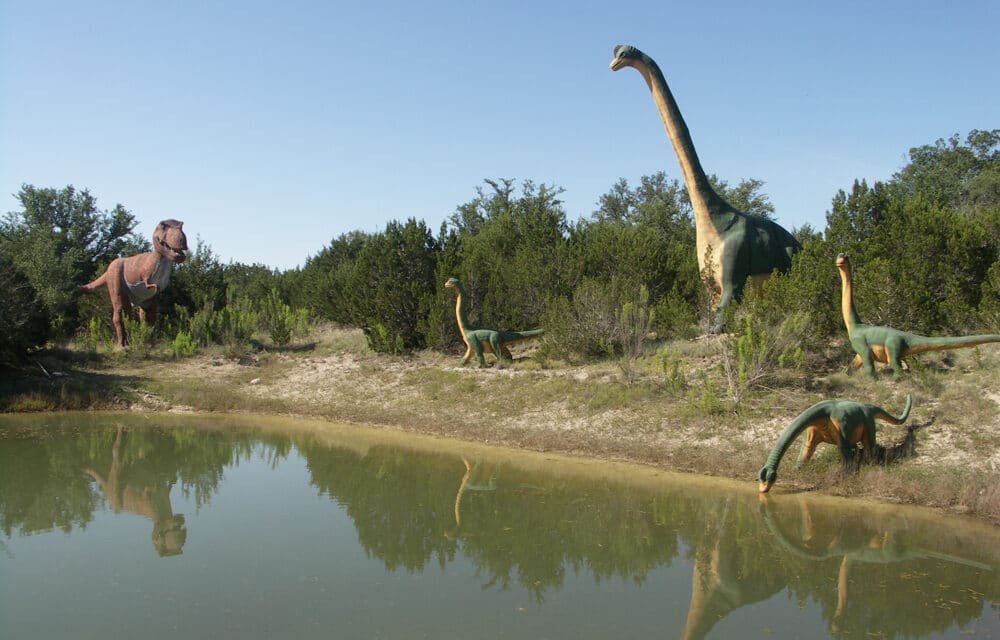(OPINION) ETH – One Bible expert has come forward to claim that a recent discovery of a brass carving of a dinosaur-like creature adorning a 500-year-old tomb in a cathedral located in England can absolutely prove that dinosaurs once roamed the Earth alongside man which destroys the theory of evolution.
Despite the narrative of scientists stating that dinosaurs’ rule on Earth ending some 66 million years ago, “Young Earth Creationists” have presented a different theory based on certain interpretations of Biblical Chronology, stating that the planet’s age can be determined by tracing the lineage of mankind from the creation of Adam and Eve in Genesis to the birth of Jesus Christ in the New Testament.
Young Earth Creationists, also estimate earth being only 6,000 to 10,000-years-old becoming a direct contradiction with the scientific estimate of 4.543 billion years.
But how does this reconcile with the fossil record and the dinosaurs scientists have told us died millions of years before us? Tom Meyer, who is a professor of Bible studies at Shasta Bible College and Graduate School in California, is claiming that there is conclusive evidence supporting the theory that dinosaurs roamed Earth at the same time as humans – evidence that he believes disproves Darwin’s theory of evolution.
Meyer believes that the brass carving of a dinosaur-like creature adorning the tomb of an English bishop buried in the Middle Ages – more than 300 years before paleontologists even coined the term “dinosaur” is hard proof.
Professor Meyer explained: “Startling evidence has come to light which demonstrates that English artisans had knowledge of what dinosaurs looked like as far back as the end of the Middle Ages.
“Some 350 years before the English biologist and paleontologist Sir Richard Owen coined the term ‘dinosaur’ in 1841, a tomb was decorated with the likeness of these creatures. “The tomb of Bishop Richard Bell, located on the floor of the famous Carlisle Cathedral in England in 1496, is the place to look.
“His tomb was elaborately decorated with brass engravings depicting all sorts of animals contemporaneous to his time such as a bat, dog, pig, fish, eels, etc. “But found among all these real and, to this very day, common animals, are depictions of two other real animals: dinosaurs.”
According to the report from Express, At first glance, the creatures appear to resemble a member of the sauropod family, which included the famous Brachiosaurus and Brontosaurus which stood on four thick legs and boast long and necks and coiled tails.
Meyer said: “Sauropods are a group of dinosaurs that had very long necks, long tails, small heads, and four thick, pillar-like legs. “They are famous for their sheer size, being among the largest animals to ever roam the Earth.
“The engravers of these dinosaurs did not have the benefit of studying dinosaur fossils or reconstructions of dinosaur skeletons in museums. “If dinosaurs became extinct 77 million years before man evolved on the earth, how did these English Middle Age artisans know how to accurately depict them?
“How did they know what these sauropods looked like if dinosaur science didn’t begin until 350 years later?” Meyer even compares the brass etchings to two known species of dinosaurs and believes one of the creatures resembled a Vulcanodon dinosaur.
The second, he added, resembles a Shunosaurus due to apparent spikes on the back of its head. Professor Meyer said: “Shunosaurus dinosaurs have only been found by paleontologists in the Sichuan Province in China. “The accuracy of the artisans’ depictions leads some to suggest that they were eyewitnesses to these dinosaurs.
“The engravings upon the tomb of Bishop Richard Bell and biblical chronology contest the conventional wisdom that dinosaurs became extinct 77 million years ago, well before man evolved via a series of chance mutations over billions of years.
“The evidence matches the biblical belief better than the evolutionary belief. “Biblical chronology unabashedly pin-points the creation of man and every land animal (including dinosaurs) to about 6,000 years ago.”
















